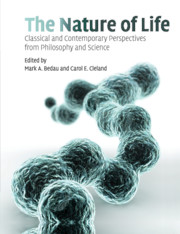Book contents
- Frontmatter
- Contents
- Preface
- Acknowledgments
- Sources
- About the authors
- Introduction
- SECTION I CLASSICAL DISCUSSIONS OF LIFE
- SECTION II THE ORIGIN AND EXTENT OF NATURAL LIFE
- 8 The origin of life: a review of facts and speculation
- 9 Small molecule interactions were central to the origin of life
- 10 Are the different hypotheses on the emergence of life as different as they seem?
- 11 The universal nature of biochemistry
- 12 Is there a common chemical model for life in the universe?
- 13 Searching for life in the universe: lessons from Earth
- 14 The possibility of alternative microbial life on Earth
- 15 Introduction to the limits of organic life in planetary systems
- SECTION III ARTIFICIAL LIFE AND SYNTHETIC BIOLOGY
- SECTION IV DEFINING AND EXPLAINING LIFE
- Supplementary bibliography on life
- Index
- References
8 - The origin of life: a review of facts and speculation
Published online by Cambridge University Press: 10 November 2010
- Frontmatter
- Contents
- Preface
- Acknowledgments
- Sources
- About the authors
- Introduction
- SECTION I CLASSICAL DISCUSSIONS OF LIFE
- SECTION II THE ORIGIN AND EXTENT OF NATURAL LIFE
- 8 The origin of life: a review of facts and speculation
- 9 Small molecule interactions were central to the origin of life
- 10 Are the different hypotheses on the emergence of life as different as they seem?
- 11 The universal nature of biochemistry
- 12 Is there a common chemical model for life in the universe?
- 13 Searching for life in the universe: lessons from Earth
- 14 The possibility of alternative microbial life on Earth
- 15 Introduction to the limits of organic life in planetary systems
- SECTION III ARTIFICIAL LIFE AND SYNTHETIC BIOLOGY
- SECTION IV DEFINING AND EXPLAINING LIFE
- Supplementary bibliography on life
- Index
- References
Summary
The problem of the origin of life on the Earth has much in common with a well-constructed detective story. There is no shortage of clues pointing to the way in which the crime, the contamination of the pristine environment of the early Earth, was committed. On the contrary, there are far too many clues and far too many suspects. It would be hard to find two investigators who agree on even the broad outline of the events that occurred so long ago and made possible the subsequent evolution of life in all its variety. Here, I outline two of the main questions and some of the conflicting evidence that has been used in attempts to answer them. First, however, I summarize the few areas where there is fairly general agreement.
The Earth is slightly more than 4.5 billion years old. For the first half billion years or so after its formation, it was impacted by objects large enough to evaporate the oceans and sterilize the surface. Well-preserved microfossils of organisms that have morphologies similar to those of modern blue-green algae, and date back about 3.5 billion years, have been found, and indirect but persuasive evidence supports the proposal that life was present 3.8 billion years ago. Life, therefore, originated on or was transported to the Earth at some point within a window of a few hundred million years that opened about four billion years ago.
- Type
- Chapter
- Information
- The Nature of LifeClassical and Contemporary Perspectives from Philosophy and Science, pp. 121 - 128Publisher: Cambridge University PressPrint publication year: 2010
References
- 2
- Cited by



